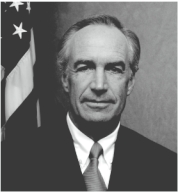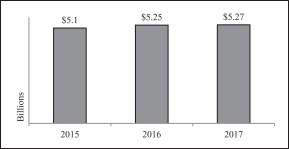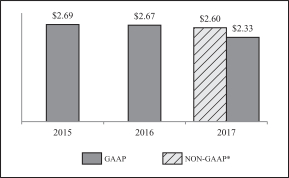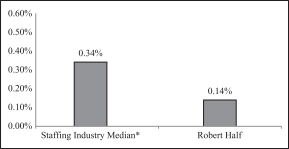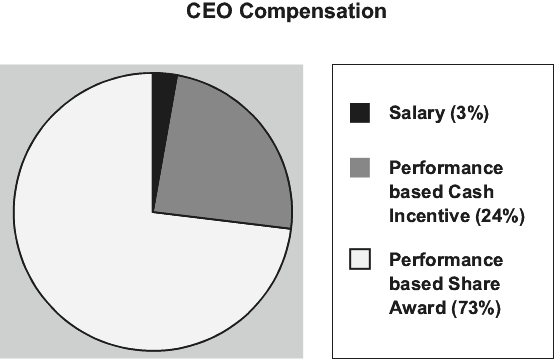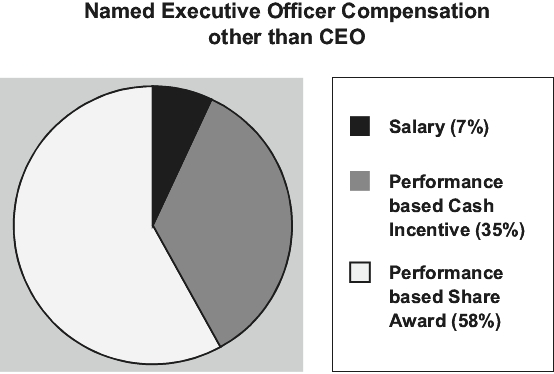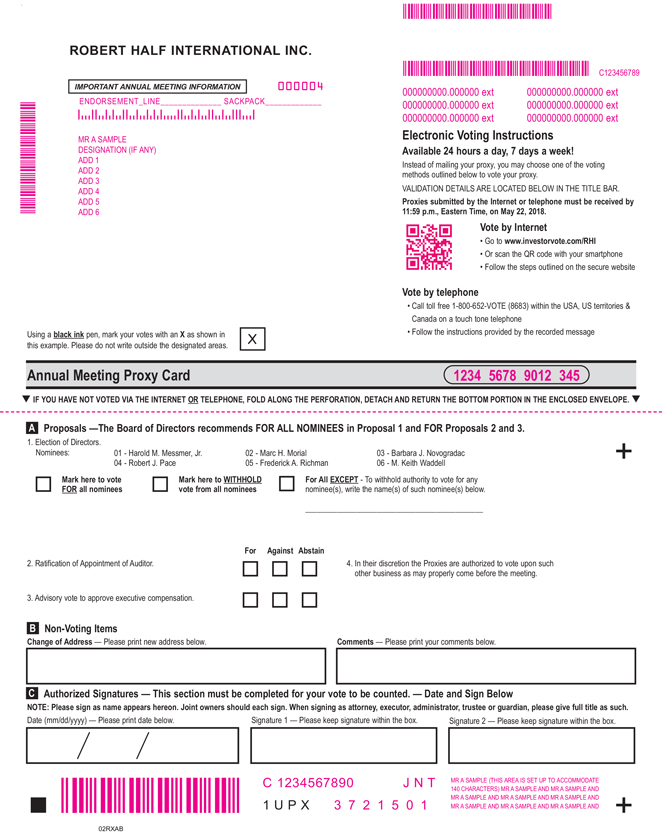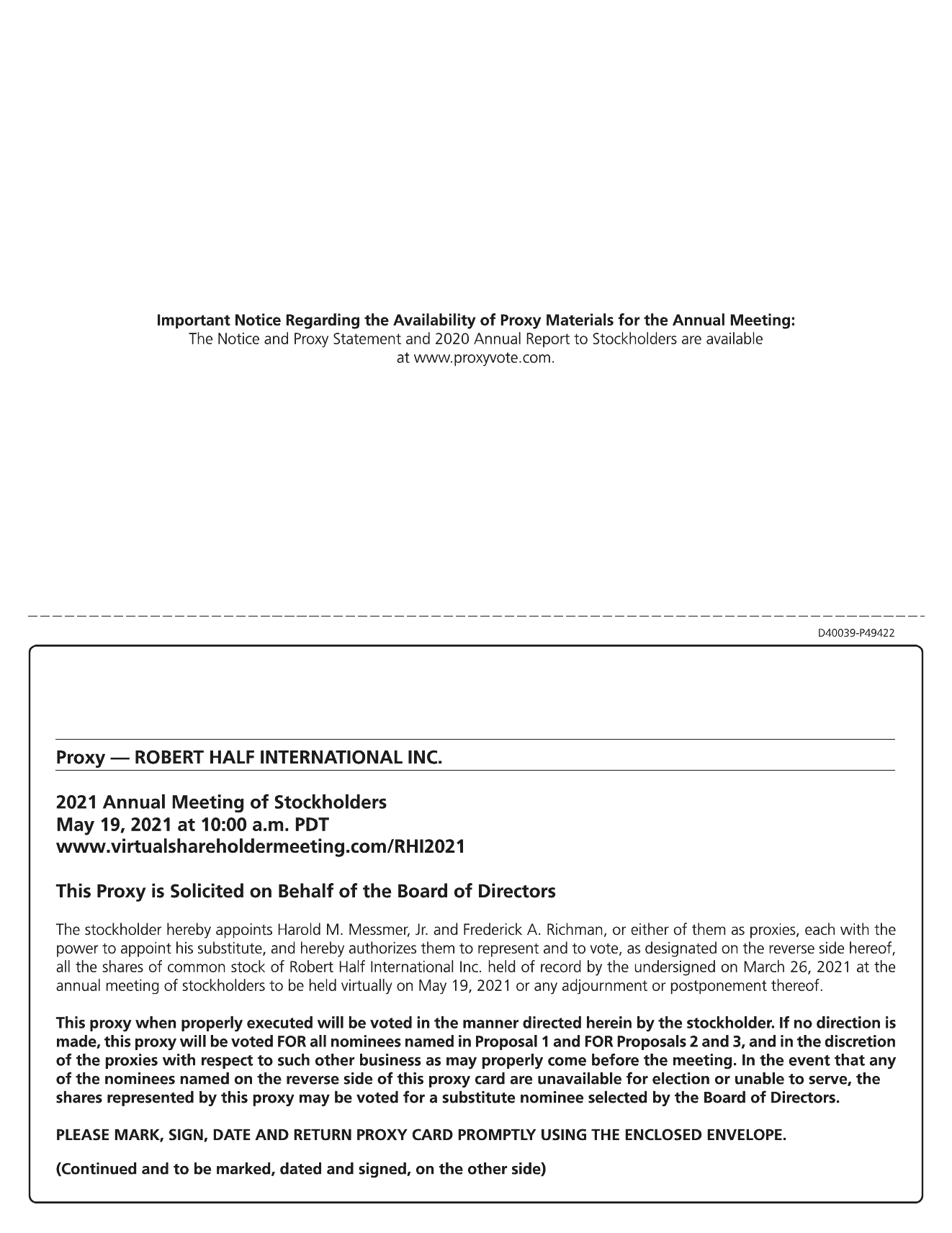The Company’s
written policy with respect to related party transactions is that directors and officers are expected to report any transaction that the Company
potentially would be required to disclose pursuant to Item 404(a) of SEC Regulation
S-K (a “Related-Party Transaction”) to the Nominating and Governance Committee. All such Related-Party Transactions shall be subject to the review and approval of the
non-interested members of the Nominating and Governance Committee. In determining whether to approve any such transaction, the Nominating and Governance Committee will consider such factors as it deems relevant, including, but not limited to, whether the transaction is on terms comparable to those that could be obtained in arm’s length negotiations with an unrelated third party. This policy is expressed in the Company’s Corporate Governance Guidelines, which
guidelines are available on the Company’s website at
www.roberthalf.comin the “Corporate Governance” section under “Investor Center.”
Section 16(a) Beneficial Ownership Reporting Compliance
To the best of the Company’s knowledge, each of the current directors and executive officers filed on a timely basis all forms required to be filed with respect to 2017 pursuant to Section 16(a) of the Securities Exchange Act of 1934.
Code of Ethics
The Company has adopted a code of ethics applicable to the directors and to all employees, including, but not limited to, the principal executive officer, the principal financial officer and the principal accounting officer. The Code of Business Conduct and Ethics is available on the Company’s website atwww.roberthalf.com in the “Corporate Governance” section under “Investor Center.”
Director Independence
The Board of Directors has determined that each of Messrs. Morial, Pace and Richman and Ms. Novogradac has no material relationship with the Company and therefore is “independent” as defined by Section 303A of the Listed Company Manual of the New York Stock Exchange. In making such determination, the Board has adopted guidelines providing that any relationship with the Company shall be deemed to benot material if (a) the director meets the independence requirements set forth in Sections 303A.02(b)(i) through 303A.02(b)(v) of the New York Stock Exchange’s Listed Company Manual and (b) the relationship is not required to be disclosed pursuant to Item 404(a) of SECRegulation S-K. Generally, such Item 404(a) requires disclosure, with certain exceptions, of transactions exceeding $120,000 in which a director or executive officer has a material direct or indirect interest.
35
Required Officer Ownership
The Board of Directors has adopted a policy regarding minimum required share ownership by the Company’s executive officers equal to six times base salary within five years of becoming an executive officer.
Details regarding such policy are available on the Company’s website atwww.roberthalf.com in the “Corporate Governance” section under “Investor Center.” Pursuant to such policy, the minimum number of shares that Messrs. Messmer, Waddell, Gentzkow, Glass and Buckley are required to own are 184,643, 93,201, 93,201, 72,099 and 55,198, respectively. Each of our executive officers owns significantly more shares than the minimum requirement.
Required Director Ownership
The Board of Directors has adopted a policy regarding minimum required share ownership by the Company’s directors. Details regarding such policy are available on the Company’s website atwww.roberthalf.com in the “Corporate Governance” section under “Investor Center.” Pursuant to such policy, each director is required to own a minimum of 10,000 shares no later than three years from the commencement of such individual’s current tenure as director. As of December 31, 2017, all of our directors exceeded the minimum ownership requirement.
Severance Benefits Policy
The Compensation Committee has adopted a “Compensation Committee Policy Regarding Severance Benefits for Executive Officers,” pursuant to which future severance agreements with any executive officer shall not, individually or in the aggregate, provide severance benefits, as defined in the policy, that exceed 2.99 times the sum of such executive officer’s base salary and annual bonus. This policy is available on the Company’s website atwww.roberthalf.com in the “Corporate Governance” section under “Investor Center.”
It should be noted that no executive officer has ever been terminated under circumstances that required severance payments.
Clawback Policy
The Compensation Committee has adopted an Executive Compensation Clawback Policy. This policy is available on the Company’s website atwww.roberthalf.com in the “Corporate Governance” section under “Investor Center.”
It should be noted that the Company has never restated its financial statements.
CEO Succession Plan
The Company’s Corporate Governance Guidelines require that the Board of Directors adopt a CEO Succession Plan and that the plan be reviewed annually. Such a plan has been adopted and it has been reviewed by the Board within the past year. Information regarding the requirements of the plan is contained in the Company’s Corporate Governance Guidelines, which guidelines are available on the Company’s website atwww.roberthalf.com in the “Corporate Governance” section under “Investor Center.”
Director Succession Plan
The Company’s Board of Directors has adopted a Director Succession Plan, which is available on the Company’s website atwww.roberthalf.com in the “Corporate Governance” section under “Investor Center.”
36
Board of Directors Leadership Structure
Harold M. Messmer, Jr. serves as both Chairman and Chief Executive Officer. In 1986, Mr. Messmer negotiated the purchase of Robert Half Incorporated, the Company’s original operating entity, which had annual revenues of approximately $7 million. Mr. Messmer then became President and Chief Executive Officer of Robert Half Incorporated, in addition to serving as President of the Company. Following a reorganization of the Company’s subsidiaries in 1988, Mr. Messmer was elected Chairman and Chief Executive Officer of the Company, positions he has held continuously since 1988. During Mr. Messmer’s tenure in both positions, the Company has experienced substantial growth. Annual revenues for 2017 were approximately $5.27 billion. The Company’s cumulative return to stockholders during Mr. Messmer’s service as both Chairman and Chief Executive Officer was over 3,454%, which is an average annual compound return of 13%. In 1988, the Company’s business consisted solely of the operation or franchising of offices placing temporary and full-time professionals in the fields of accounting and finance. Under Mr. Messmer’s tenure, the Company has (a) expanded its placement services to include temporary and full-time professionals in the office, administrative, technology, legal and creative fields, (b) acquired all of its franchisees, and (c) created a subsidiary named Protiviti that provides business consulting and internal audit services. The Company has also expanded its operations from the United States into more than 18 countries on five continents. The Company and Mr. Messmer have received numerous accolades. In January 2018, Robert Half was named first in its industry on FORTUNE® magazine’s “World’s Most Admired Companies” list, marking the Company’s 20th consecutive annual appearance on the “Most Admired Companies” list. In May 2017, Robert Half was ranked first on theForbes list of “America’s Best Professional Search Firms” and named to theForbes list of “America’s Best Executive Search Firms.” In January 2017, Mr. Messmer was named byStaffing Industry Review magazine to its “Staffing Hall of Fame,” honoring individuals named to its annual “Staffing 100” list each year since the list’s inception in 2011, and in October 2016, the American Staffing Association inducted Mr. Messmer into the ASA Leadership Hall of Fame. In April 2017, Robert Half was listed by Forbes as one of “America’s Most Trustworthy Companies” based on accounting and governance practices and, in April 2016, was named to theForbes list of “America’s Best Large Employers.” In November 2015, Mr. Messmer was named one of FORTUNE® magazine’s “Businesspersons of the Year,” an annual list of 50 top CEOs based on the Company’s financial results in the most recent12- and36-month periods. In February 2018, Robert Half was selected from among the 1,000 largest publicly held U.S. businesses to be named to Barron’s magazine’s inaugural “100 Most Sustainable Companies” list. The Company was listed on the FTSE4Good Responsible Investment Index from 2008 through 2015. In December 2015, Mr. Messmer was named for the second consecutive year in the Company’s applicable business sector toInstitutional Investor magazine’s“All-America Executive Team,” which honorstop-ranked Chief Executive Officers (as determined bybuy-side institutional investors). In 2011, Mr. Messmer received the Staffing Innovator Award from Staffing Industry Analysts, Inc. and was named by theSan Francisco Business Times as the San Francisco Bay Area’s Most Admired CEO in the large public company category. Mr. Messmer was elected to the San Francisco Bay Area Council Business Hall of Fame in 2010, was named Ernst & Young’s “Entrepreneur of the Year” in 2007, and was selected by Morningstar, Inc. as 2003 “CEO of the Year.” In February 2018, Robert Half subsidiary Protiviti was named for the fourth consecutive year to the FORTUNE® 100 Best Companies to Work For® list, which recognizes companies with exceptional workplace cultures and talent development. Robert Half staffing and Protiviti offices regularly appear on local “best workplaces” lists, including in the San Francisco Bay Area, where the Company is headquartered. In light of the considerable success the Company has experienced under Mr. Messmer’s leadership, the Board of Directors believes it was appropriate to have him serve as both Chairman and Chief Executive Officer.
Frederick A. Richman has been designated Lead Director. Mr. Richman’s duties include, among other things, presiding at executive sessions of the independent directors, working with the Chairman to establish agendas and schedules for Board of Directors meetings, and approving the retention of any consultants retained by the Board of Directors. The Company’s Board of Directors has adopted a Lead Director Statement of Duties, which contains further information regarding the role of the Lead Director and is available on the Company’s website atwww.roberthalf.com in the “Corporate Governance” section under “Investor Center.”
37
The Board of Directors believes that this leadership structure with a Chairman and Chief Executive Officer and Lead Director provides balance and currently is in the best interest of the Company and its stockholders. The role given to the Lead Independent Director helps ensure a strong independent and active board: The Lead Independent Director has responsibility for providing input on agendas as well as the power to call and preside over meetings of the independent directors. The Lead Director also facilitates the Board’s performance evaluation of the CEO in conjunction with the Compensation Committee. Meanwhile, Mr. Messmer’s continued engagement as Chairman enables the Company and the Board to continue to benefit from his skills and expertise, including his extensive knowledge of the Company and its industry, and his experience successfully navigating the Company through both strong and challenging periods.
Risk Oversight Role
The Board of Directors exercises its risk oversight function in a variety of ways, both directly and through its various committees.
The Board of Directors reviews and approves the Company’s annual strategic plan. At its meetings, it receives reports from the Chairmen of its committees. The Board also periodically receives presentations from the heads of the Company’s various operating departments. Compliance policies are reviewed at least annually and updated from time to time as the Board deems appropriate.
As prescribed in its charter, the Audit Committee monitors guidelines and policies that govern the process by which risk assessment and management is undertaken. The Audit Committee receives a quarterly written report from the manager of the Company’s internal audit and risk management function and discusses the report with the manager. The Audit Committee reviews and adopts the budget of the internal audit and risk management department and also reviews and approves, in advance, the scope and the staffing of the internal audit. Any complaints to the Company’s Corporate Compliance and Ethics Hotline are automatically routed to the Chairman of the Audit Committee in addition to the appropriate management personnel.
The Compensation Committee approves all executive compensation programs. It believes that the emphasis on time vesting equity compensation encourages executive officers to take a long-term view when making decisions. In addition, both cash bonuses and share awards are subject to the Company’s Clawback Policy, which is available on the Company’s website atwww.roberthalf.com in the “Corporate Governance” section under “Investor Center.”
Available Information
The Company’s Corporate Governance Guidelines, Code of Business Conduct and Ethics, and charters for its Audit Committee, Compensation Committee and Nominating and Governance Committee are available on its website,www.roberthalf.com, in the “Corporate Governance” section under “Investor Center.” Each of these documents is also available in print to any stockholder who makes a request to Robert Half International Inc., 2884 Sand Hill Road, Menlo Park, CA 94025, Attn: Corporate Secretary.
38
THE BOARD AND COMMITTEES
The Board met six times during 2017. Each of the directors attended at least 75% of the aggregate number of meetings of the Board and of the committees of the Board held while a member thereof.
It is the Company’s policy that directors are expected to attend the annual meeting of stockholders. All of the then-serving directors attended the 2017 annual meeting of stockholders.
The Board of Directors has standing Audit, Compensation, Nominating and Governance, and Executive Committees.
The Audit Committee, currently composed of Messrs. Morial and Richman and Ms. Novogradac, met five times during 2017. Ms. Novogradac is the Chairwoman of the Audit Committee. The functions of the Audit Committee include selecting the Company’s independent auditors (subject to stockholder ratification), approving the fees of the independent auditors, monitoring the qualifications and independence of the independent auditors, consulting with the independent auditors with regard to the plan of audit, the results of the audit and the audit report, conferring with the auditors with regard to the adequacy of internal accounting controls, and monitoring the effectiveness of the Company’s internal accounting function.
The Compensation Committee, currently composed of Messrs. Pace and Richman and Ms. Novogradac, met five times during 2017. Mr. Richman is the Chairman of the Compensation Committee. The function of the Compensation Committee is to establish compensation policies for the Company’s senior officers and to administer compensation plans in which officers, directors and employees are eligible to participate.
The Nominating and Governance Committee, currently composed of Messrs. Morial, Pace and Richman, met two times during 2017, and Mr. Richman is the Chairman of the Nominating and Governance Committee. The Nominating and Governance Committee’s role is to recommend candidates to fill any vacancy that may occur in the Board of Directors, develop and recommend corporate governance guidelines to the Board, and oversee the evaluation of the Board and management.
The Executive Committee, currently composed of Messrs. Messmer, Pace and Richman, did not meet during 2017. The Executive Committee has all of the powers of the Board of Directors, with certain specific exceptions required by Delaware law.
The Company’s independent directors meet regularly in executive session without management. Such meetings are presided by the Lead Director, who currently is Frederick A. Richman.
The members of the committees and their independence status, as of the date of this proxy statement, and the number of committee meetings during fiscal 2017 are identified in the following table.
| | | | | | | | | | | | |
| Director Nominees | | Independent | | | Audit
Committee | | Compensation
Committee | | Nomination and
Governance Committee | | Executive Committee |
Harold M. Messmer, Jr. | | | | | | | | | | | | X |
Marc H. Morial | | | X | | | X | | | | X | | |
Barbara J. Novogradac | | | X | | | Chair | | X | | | | |
Robert J. Pace | | | X | | | | | X | | X | | X |
Frederick A. Richman | | | X | | | X | | Chair | | Chair | | Lead Director |
M. Keith Waddell | | | | | | | | | | | | |
Number of Meetings | | | | | | 5 | | 5 | | 2 | | 0 |
39
Nominating and Governance Committee
Nominating and Governance Committee Charter
The Nominating and Governance Committee has adopted a charter, which it reviews regularly and updates as the Board deems appropriate. The current Nominating and Governance Committee charter is available on the Company’s website,www.roberthalf.com, and can be found in the “Corporate Governance” section under “Investor Center.”
Submission to Nominating and Governance Committee of Suggested Nominees for Director
The Nominating and Governance Committee will consider director candidates recommended by stockholders. A stockholder wishing to submit a candidate to the Nominating and Governance Committee for consideration as nominee for director may submit a written recommendation, including the proposed candidate’s name and address, résumé, and other information required for nominations submitted under Section 9(a)(2) of Article II of ourBy-laws, to Robert Half International Inc., 2884 Sand Hill Road, Menlo Park, CA 94025, Attn: Corporate Secretary—Director Candidate. The Corporate Secretary will forward the information to the Nominating and Governance Committee. Please note that Article II, Section 9(a)(2) of ourBy-laws—which are posted on our website,www.roberthalf.com, in the “Corporate Governance” section under “Investor Center”—prescribes certain timing and other requirements for nominations and other business to be properly brought before an annual meeting. In addition, stockholders wishing to have their director candidate included in our proxy materials for an annual meeting must comply with Article II, Section 9(a)(3) of ourBy-laws (see “Stockholder Matters—Presentation of Business at Annual Meeting of Stockholders” for additional details on how to submit a director nominee for our 2019 annual meeting of stockholders).
Consistent with our Corporate Governance Guidelines, the Nominating and Governance Committee uses the same criteria for evaluating candidates regardless of the source of referral. The Nominating and Governance Committee recommends to the Board director candidates for nomination and election at the annual meeting of stockholders or for appointment to fill vacancies. In evaluating individuals for nomination as director, the Nominating and Governance Committee shall select individuals who (a) have skills and experience that can be of assistance to management in operating the Company’s business, (b) demonstrate integrity, accountability and judgment and (c) can be expected to add to the total mix of individuals on the Board of Directors so as to give the Company a Board that exhibits effectiveness, collegiality, diversity and responsiveness to the needs of the Company. Diversity is not further defined in the Corporate Governance Guidelines, but is applied in its broadest sense so as to encourage the selection of a diverse group of Board members that will give the Company the benefit of a wide mix of talent, experience and skills. Other factors that may be considered include (i) experience with small tomid-size businesses (the Company’s principal client base), (ii) a record of entrepreneurial success and/or (iii) financial or accounting experience.
Audit Committee
Audit Committee Charter
The Company’s Board of Directors has adopted a charter for the Audit Committee, which it reviews regularly and updates as it deems appropriate. The current Audit Committee charter is available on the Company’s website,www.roberthalf.com, and can be found in the “Corporate Governance” section under “Investor Center.”
Independence
The Board of Directors has determined that all of the members of the Audit Committee are independent as defined in the New York Stock Exchange’s listing standards.
Audit Committee Financial Expert
The Board of Directors has also determined that Frederick A. Richman and Barbara J. Novogradac, Chairwoman of the Audit Committee, each qualifies as an “audit committee financial expert” and “independent”
40
in accordance with the requirements of Item 407(d)(5) of SEC RegulationS-K and the rules and regulations of the New York Stock Exchange.
Audit Committee Report
Notwithstanding anything to the contrary set forth in any of the Company’s previous or future filings under the Securities Act of 1933 or the Securities Exchange Act of 1934 that might incorporate by reference this Proxy Statement or future filings with the SEC, in whole or in part, the following information shall not be deemed to be incorporated by reference into any such filings.
The Audit Committee has reviewed and discussed the audited financial statements for the year ended December 31, 2017, contained in the Company’s Annual Report on Form10-K (the “2017 Financial Statements”) with the Company’s management. The Audit Committee has discussed with PricewaterhouseCoopers LLP (“PwC”), an independent registered public accounting firm that is the Company’s independent auditors, the matters required to be discussed by Auditing Standard No. 1301 adopted by the Public Company Accounting Oversight Board regarding “Communication with Audit Committees.” The Audit Committee has also received the written disclosures and the letter from PwC required by applicable requirements of the Public Company Accounting Oversight Board regarding PwC’s communications with the Audit Committee concerning independence and has discussed PwC’s independence with them. Based on the foregoing review and discussions, the Audit Committee has recommended to the Company’s Board of Directors that the 2017 Financial Statements be included in the Company’s Annual Report on Form10-K.
| | | | |
Marc H. Morial | | Barbara J. Novogradac | | Frederick A. Richman |
Compensation Committee
Compensation Committee Charter
The Compensation Committee has adopted a charter, which it reviews regularly and updates as the Board deems appropriate. The current Compensation Committee charter is available on the Company’s website,www.roberthalf.com, and can be found in the “Corporate Governance” section under “Investor Center.”
Independence
The Board of Directors has determined that all of the members of the Compensation Committee are independent as defined in the New York Stock Exchange’s listing standards.
Compensation Committee Procedures
Each component of executive compensation is determined by the Compensation Committee. The Compensation Committee determines what changes, if any, should be made to continuing arrangements, such as base salaries and fringe benefits. When determining compensation for the coming year, the Compensation Committee reviews (a) the Company’s results for the prior year, (b) the issues that will confront the Company in the coming year, (c) the individual performance of the executive officers, (d) the need to set compensation at levels that promote retention and (e) such other information it deems appropriate. After such review, it makes its ultimate determinations based upon its evaluation of such information and its long-term experience with the Company. While the Compensation Committee receives input from the Chief Executive Officer and Chief Financial Officer and discusses compensation with them, the ultimate decision regarding compensation is solely at the discretion of the Compensation Committee. For further information, see the CD&A above. The Compensation Committee has the authority to retain consultants to assist with its decisions. The Compensation Committee has retained FW Cook as its independent compensation consultant to help the Compensation Committee establish and implement its compensation philosophy, to evaluate compensation proposals recommended by management, and to provide advice and recommendations on competitive market practices and
41
specific compensation decisions for executive officers and directors. The Compensation Committee retains and does not delegate any of its exclusive power to determine all matters of executive compensation and benefits, although the CEO and the CFO present compensation and benefits proposals to the Compensation Committee, except with respect to their own compensation. FW Cook works directly with the Compensation Committee (and not on behalf of management) to assist the Compensation Committee in satisfying its responsibilities and has not undertaken any projects for management. For additional description of the Compensation Committee’s processes and procedures for consideration and determination of executive officer compensation, see the CD&A above.
Compensation of directors is determined by the full Board of Directors, except for equity awards under the Stock Incentive Plan, which are made by the Compensation Committee.
Compensation Committee Interlocks and Insider Participation
The members of the Compensation Committee during 2017 were: Barbara J. Novogradac, Robert J. Pace, Frederick A. Richman, and, until his retirement in May 2017, Andrew S. Berwick. No member of the Compensation Committee was at any time during 2017 or at any other time an officer or employee of the Company, except for Ms. Novogradac (whose employment ended in 2001), and no member of the Compensation Committee had any relationship with the Company requiring disclosure under Item 404 ofRegulation S-K. No executive officer of the Company has served on the board of directors or compensation committee of any other entity that has or has had one or more executive officers who served as a member of the Compensation Committee during 2017.
Compensation Committee Report
The Compensation Committee has reviewed and discussed with management the CD&A appearing earlier in this proxy statement. Based on this review and discussion, the Compensation Committee has recommended to the Board of Directors that the CD&A be included in this proxy statement.
| | | | |
Barbara J. Novogradac | | Robert J. Pace | | Frederick A. Richman |
Stockholder Communications with Directors
Stockholders or other interested persons who wish to communicate with any director, with thenon-management directors as a group, or the entire Board may do so by addressing communications to such person or persons c/o Robert Half International Inc., 2884 Sand Hill Road, Menlo Park, CA 94025, Attn: Corporate Secretary—Director Communication. The Corporate Secretary or her delegee will forward such communication to the addressee unless she determines that the communication is not suitable for delivery. Examples of communications that would not be suitable for delivery include, but are not limited to, (a) advertisements or solicitations, (b) frivolous, obscene or offensive items, and (c) communications unrelated to the business, affairs or governance of the Company.
42
INDEPENDENT REGISTERED PUBLIC ACCOUNTING FIRM
The Audit Committee has selected PricewaterhouseCoopers LLP, an independent registered public accounting firm, to audit the books, records and accounts of the Company for 2018, subject to ratification by stockholders. PricewaterhouseCoopers LLP has acted as auditors of the Company since 2002. Representatives of that firm will be present at the Meeting and will have the opportunity to make a statement if they desire to do so. They will also be available to respond to questions.
PricewaterhouseCoopers’ charges for 2016 and 2017 were as follows:
| | | | | | | | |
| | | 2016 | | | 2017 | |
Audit Fees | | $ | 2,151,799 | | | $ | 2,275,449 | |
Audit-Related Fees | | $ | 51,426 | | | $ | 207,750 | |
Tax Fees | | $ | 0 | | | $ | 0 | |
All Other Fees | | $ | 0 | | | $ | 9,000 | |
The 2016 and 2017 Audit-Related Fees were incurred in connection with attest services relating to reviews of financial information for wholly owned subsidiaries of the Company. In addition, in 2017, Audit-Related Fees were incurred relating to the adoption of a new accounting standard, effective for the Company on January 1, 2018. All Other Fees for 2017 include software subscriptions. Rule2-01(c)(7)(i)(C) of SECRegulation S-X (relating to waivers with respect to the requirement that fees bepre-approved) was not applicable to any of the services for 2016 or 2017 described in the above table.
Audit Committee Policy RegardingPre-Approval of Services of Independent Auditors
The Audit Committeepre-approves all audit and permissiblenon-audit services provided by the independent auditors. These services may include audit services, audit-related services, tax services and other services. The Audit Committee has adopted a policy for thepre-approval of services provided by the independent auditors. Under the policy,pre-approval is generally provided for up to one year, and anypre-approval is detailed as to the particular service or category of services and is subject to a specific budget. In addition, the Audit Committee may alsopre-approve particular services on acase-by-case basis. For each proposed service, the independent auditor is required to provide detailedback-up documentation at the time of approval. The Audit Committee may delegatepre-approval authority to one or more of its members. Such a member must report any decisions to the Audit Committee at the next scheduled meeting.
Required Vote
The affirmative vote of the holders of a majority of the outstanding shares of Common Stock present in person or by proxy at the Meeting and entitled to vote is required for ratification of the appointment of PricewaterhouseCoopers LLP as auditors for 2018.
Board Recommendation
THE BOARD OF DIRECTORS UNANIMOUSLY RECOMMENDS THAT STOCKHOLDERS VOTE “FOR” RATIFICATION OF THE APPOINTMENT OF PRICEWATERHOUSECOOPERS LLP AS AUDITORS. PROXIES SOLICITED BY THE BOARD WILL BE SO VOTED UNLESS STOCKHOLDERS SPECIFY A CONTRARY CHOICE IN THEIR PROXIES.
43
ADVISORY VOTE ON EXECUTIVE COMPENSATION
Stockholders are entitled to cast an advisory vote at the Meeting to approve the compensation of the Company’s named executive officers, as disclosed in this proxy statement. This vote is not intended to address any specific item of compensation, but rather the overall compensation of the Company’s named executive officers and the philosophy, policies and practices described in this proxy statement. Although, pursuant to the Dodd-Frank Act, the vote isnon-binding, the Compensation Committee and the Board of Directors will consider the outcome of the vote in establishing compensation philosophy and making future compensation decisions.
In May 2017, approximately 93% of stockholder votes approved the Company’s 2016 executive compensation. Consistent with its pay for performance policy, the 2017 bonus and performance shares are based on Company performance as set forth below.
The Compensation Committee set target bonuses for 2017 at the same levels as 2016 target bonuses. In addition, revenue and net income targets were set to emphasize achievement of both top line and bottom line growth. Actual 2017 performance was achieved at 95% of target net income and 99% of target revenue. As a result bonuses for 2017 were equal to 96.6 % of target 2017 bonuses.
All equity awards issued to executive officers during 2017 were again 100% performance shares and were subject to three-year cliff vesting and two performance conditions—an annual EPS condition and a modifier based on cumulative ROIC relative to the three-year cumulative ROIC of an industry peer group. The complete results for the 2017 performance shares will not be known until the end of 2019. The 2015 performance shares, which just completed their three-year performance period during 2017, will vest at 50% of target based on relative TSR performance.
The Compensation Committee believes that 2017 compensation is directly aligned with performance.
Stockholders are asked to indicate their support for our named executive officer compensation as described in this proxy statement by voting FOR the following resolution at the Meeting:
“RESOLVED, that the compensation paid to the Company’s named executive officers, as disclosed pursuant to Item 402 of RegulationS-K, including the Compensation Discussion and Analysis, compensation tables and narrative discussion, is hereby approved.”
Required Vote
The affirmative vote of the holders of a majority of the outstanding shares of Common Stock present in person or by proxy at the Meeting and entitled to vote is required for approval of the proposal.
Board Recommendation
THE BOARD OF DIRECTORS UNANIMOUSLY RECOMMENDS THAT STOCKHOLDERS VOTE “FOR” THE PROPOSAL RELATING TO EXECUTIVE COMPENSATION. PROXIES SOLICITED BY THE BOARD WILL BE SO VOTED UNLESS STOCKHOLDERS SPECIFY A CONTRARY CHOICE IN THEIR PROXIES.
44
STOCKHOLDER MATTERS







